Although the oldest finds concerning wine undoubtedly come from Mesopotamia, Greece can justifiably be considered the cradle of wine for Central Europe. Venerable, but until recently strangely lacklustre, due not least to the fact that the country was occupied for centuries by the Turks, who hardly allowed any viticulture. As much as the wine industry used to stagnate, it now presents itself as active and forward-looking. This is not only due to the EU subsidies, which are also available to others, but for the most part to a noticeable desire to once again take a place in the wine world that is fair to the country. When more than 40 years ago Porto Carras (Halkidiki) started its work with the best trained oenologists, a renaissance of Greek viticulture began that has continued unbroken until today.
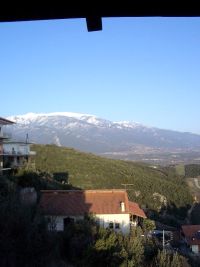 |
| The Olymp% "divine terroir" |
For years, the growing number of quality wineries in northern Greece were the typical lone wolves, until in 1993, 13 wineries decided to found a non-profit organisation: the "Wineroads of Macedonia" were born, also including the regions of Rapsani, Xanthi and Rhodopi, which are not in Macedonia. More recently, the region of Epirus was added and the organisation is now called "The Wine Roads of Northern Greece". From the very beginning, it was clear to the association that it would not make sense if only wineries were members. Of course, they form the backbone, but what would the best wine be without the typical food of the country, the culture and inviting accommodation. Consequently, the "Wine Routes of Northern Greece" see themselves as a comprehensive contact point for all gourmets who want to experience the immensely varied regions up close. The emphasis is on the authentic, the regional, i.e. what is rightly called "terroir". In order to guarantee this, every business, whether it is a winery, restaurant, food or hotel, is thoroughly checked to see if it meets the admission criteria.
As indicated in the title, autochthonous varieties were the reason to take a closer look at some areas. A few, one would be tempted to say, because Greece has a unique variety of them, rumoured to be over 400.
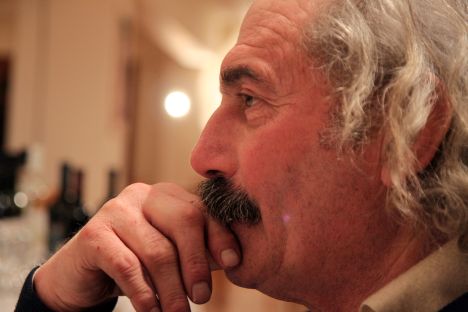 |
| Anestis Babatzimopoulos%© Sonja Graminski |
The journey began in Ossa (Thessaloniki Wine Route), a small town 60 km north of Thessaloniki. That is to say, not quite, because far before the town you turn into the gravelled road to the Babatzim winery. What sounds so exotic comes from the sober realisation of the owner that you should be able to pronounce the name of a winery even if you don't speak Greek. Although the personality of the owner, Anestis Babatzimopoulos, is so dazzling and multi-faceted that after a visit you would remember the whole name without batting an eyelid.
The farm itself has a long tradition as a distillery, but Anestis only came to wine a little more than 30 years ago. A good decision, because at 650 m above sea level, the temperature differences between day and night are much greater than on the plain. Apart from that, different soils such as slate, calcareous gravel and clay literally invite you to plant vines. This has happened extensively here in the sense that no less than 26 varieties are cultivated, whether allowed as quality varieties in the area or not. "How else am I supposed to know which of the many autochthonous and international varieties will really prove their worth in my area?" comments Anestis, shrugging his shoulders with Greek mischievousness on his neck. A small excerpt: Agiorgitiko, Xynomavro, Negoska, Mavroudi, Asyrtiko, Athiri, Moschofilero, Moscato Aspro, Malagouzia, but also Cabernet Sauvignon, Cabernet Franc and Merlot. Because you soon forget how things really taste, he is also currently building a so-called "pleasure laboratory" in the form of a large house in the middle of the vineyards, where natural food will be cooked and wine drunk to go with it, children can get to know unadulterated smells and tastes again in courses, and all the senses are to get their money's worth. The view of distant Olympus adds to the experience. There is also a public orchard, and soon there will be a natural amphitheatre in the middle of the grounds. The wines are accessible across the board, uncomplicated but with character and perfectly matched to the food.
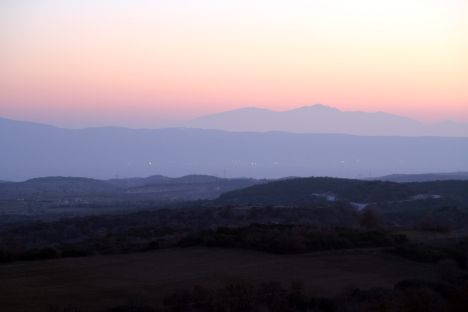 |
| View of Mount Olympus at dusk% © Sonja Graminski |
Late in the evening, we headed for Rapsani, the "Wine Route of the Olympian Gods". The late arrival was to blame for the fact that no one saw Mount Olympus either. But the next morning made it clear why this wine road is so called. The view from the hotel "Castello" to the sea and the fortress, on the other hand to the mighty, dazzling white snow-covered massif of Mount Olympus was impressive.
 |
| Dr. Katsaros |
No less impressive was the drive to the Katsaros winery in Krania. The road winds its way up the mountain in countless twists and turns, and after half an hour one wonders where wine is supposed to grow here. And yet, here and there, you see small vineyards on the slopes, difficult to work, but all well tended. Finally, you stand in front of the winery and admire the magnificent "alpine" panorama of the 2000m high mountain Kissavos, unbelievable and unexpected, yet less than 30km from the sea. The altitude is a good 750 m, and wine grows here. Dr. Dimitrios Katsaros cultivates 10 hectares on the slopes of the mountain Kato Olympos, mainly Cabernet Sauvignon, Merlot and Chardonnay. In 1978, as a hobby, he started making wine; the architecturally appealing building is now, as it was then, the family's holiday home. After years of trials, Katsaros realised that the indigenous varieties did not mature sufficiently at this altitude and was one of the first to plant Cabernet Sauvignon in Greece. From 1985 onwards, the wine could also be bought, it was the beginning of a successful winemaking career. From the very beginning, the rather introverted ENT doctor orientated himself on Bordeaux, both in the development and in the demand. "I make the wine that I personally like," is the statement of the Bordeaux connoisseur. For years, this taste has visibly been shared by many, because the 15 000 bottles of his high-priced cuvée Domaine Katsaros made from Cabernet and Merlot are regularly sold out. Nevertheless, Dimitrios Katsaros is always on the lookout, not satisfied with what he has achieved so far. He is in active contact with the few colleagues and oenologists who also press such special wines and is constantly trying to get closer to his ideal. Although the main focus is on the red wines, the Chardonnay, partly aged in barrique, is also very remarkable. All in all, the wines are interesting and independent, some vintages also surprisingly storable.
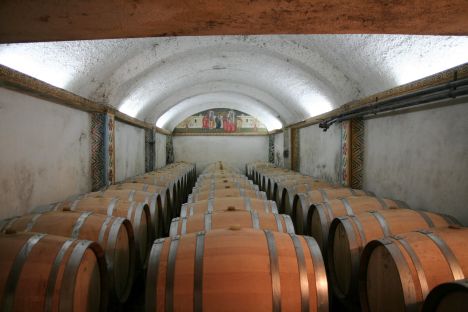 |
| The cellar of the Katsaros winery%© Sonja Graminski |
The contrast could hardly be greater when, right after the small, individual winery, we visited the supra-regionally and internationally active Tsantali winery in Rapsani. With one restriction: the central winery is on Halkidiki, in Rapsani there is only the building necessary for the local grapes. Tsantali began in 1945 as a distillery in Thessaloniki, and the ouzo quickly became the best-selling in Greece. Wine production began in Naoussa in 1970, and today the company processes grapes from 7 regions and is the largest in Greece with an output of 20 million bottles. Despite this size, interesting, quite individual and also storable wines can be found in the range. They are not least the result of first-class vineyard work in a style that one would actually only expect from smaller wineries. This can be seen in Rapsani, where the individual vineyards (over 50ha in total) are widely scattered in different exposures and altitudes. In the tradition-steeped municipality, already one of the first regions to be awarded the protected designation of origin O.P.A.P. in 1970, wines from the sites with iron-rich slate (weathering) tend to be taut, those from the lower-lying sandy soils rather soft. The individual vineyards are hardly larger than one hectare. In many cases you can still see cane cultures here, otherwise the canes are grown rather low. On the basis of some wines from the vinotheque, one could get a good idea of the storability of the cuvées from the varieties Xynomavro, Krassato and Stavroto, even wines over 10 years old cut a good figure.
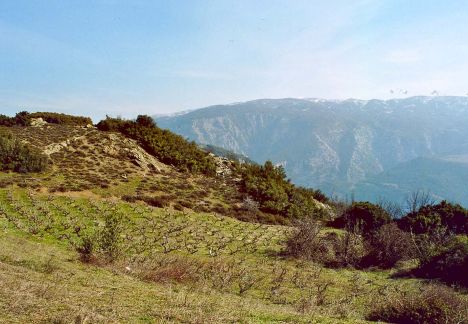 |
| Rapsani vineyard with the Kissavos mountain in the background |
The third winery in the region we visited was Dougos Winery, located in the picturesque Tempital. Around the clearly structured building, which fits into the landscape, you can test your ampelographic knowledge on 29 different varieties planted here for demonstration purposes. The Dougos family started growing grapes in 1992, focusing on both quality and working the vineyards as close to nature as possible. Here you will find a relaxed mix of autochthonous and "new" varieties, which is best reflected in Meth'Imon, a blend of Syrah, Merlot, Cabernet Franc, Limniona, Batiki, Grenache and Cabernet Sauvignon.
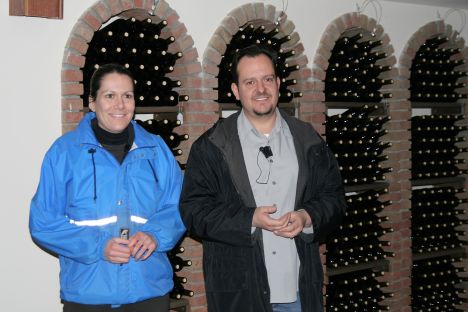 |
| Louisa & Thanos Dougos% © Sonja Graminski |
The cellar is modern and spotlessly clean, but without high-tech; the cellar master Louisa is Thanos Dougos' sister, she studied oenology in France, he is an agricultural engineer. When the two present their wines, explain the work in the vineyards and meticulously describe the ageing of the wines, you notice their passion for nature and winemaking. Everything seems easy here, "organic farming is easy for us, we don't need to do anything", or "the wines will develop on their own", you would hardly believe that there is so much work behind it in reality, not to mention the knowledge. At the moment, the question of whether acacia wood is not better for the finishing touches to the white wine is moving the minds of both. Most of the wines seem to have taken on the almost playful manner of the siblings, except for a Syrah with over 15% alcohol, which somewhat resembles an Amarone.
Continue here...